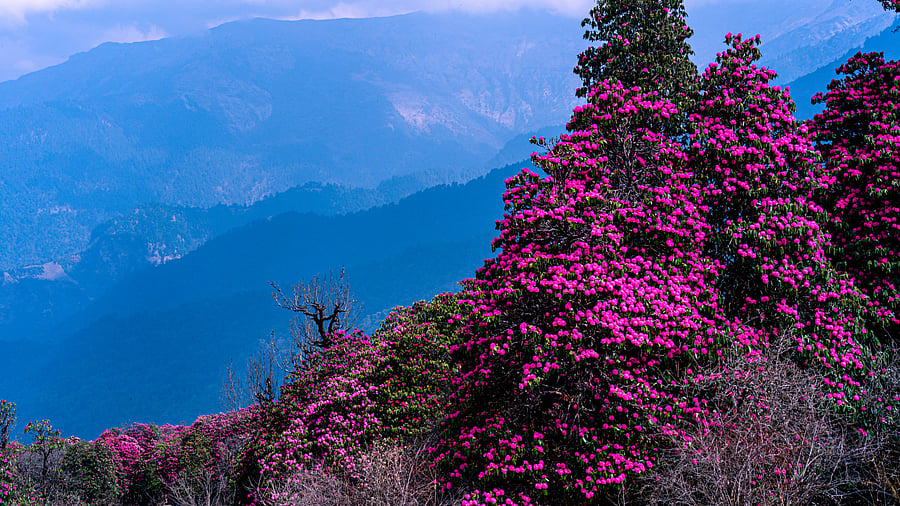
Credit: Special Arrangement
I could barely lift my head as I wound through Poon Hill in Nepal — sleepless and aching under my 45-litre backpack. The grassy trail turned red-pink and stretched on. A raindrop landed on my head, forcing me to sprint for cover under a tree. I looked up. Crimson flowers, clustered in rounded bunches, shot through oblong emerald leaves, blocking my view of the sky. Around me, red-and-green trees contrasted with the grey valley and snow-dusted peaks in the distance. Smiling, I stood there. “Our national flower. Rhododendron,” my trek guide said, fumbling with the name. It was mid-March 2015 and chilly. I was shepherded towards the 3,210-metre peak.
Over subsequent travels, I learned rhododendrons weave through Himalayan cultures, and are known by various names: talisfer in Kashmir, buraa(n) in Himachal Pradesh, buransh in Uttarakhand, etok in Sikkim, mento in Arunachal Pradesh, and lali gurans in Nepal. Their flowering marks the arrival of spring, a brief window between winter’s chill and summer heat, now increasingly uncertain due to climate change. But I’ve been lucky.
Halfway through the gruelling Sandakphu-Phalut Trek in West Bengal, I regretted my decision — until familiar scarlet bell-shaped blooms appeared along the trail, putting a spring back in my step. On the Bedni Bugyal trek in Uttarakhand, I pointed out excitedly to my husband and friend: “Look — the whole valley is red!” Only to discover my companions were colour blind. In Sikkim, I saw them in a different light — soft pink-orange by Tsomgo Lake, lavender in Yumthang Valley. In Tawang, Arunachal, red and white blooms by a nunnery gave me the perfect excuse to catch my breath. Last month in Himachal, rhododendrons were everywhere — on trees, in chutney, tea and juice, and even in squash and wine bottles.
Buransh tea in Bri-Billing Himachal
Credit: Special Arrangement
Like daughters coming home...
The locals I met and later connected with found my questions on rhododendron amusing. To them, rhododendrons were routine — a flower in their backyard. But as I pressed further, childhood memories surfaced: wearing them in their hair, selling them to trekkers for a quick buck, or sipping nectar from the blooms and getting ‘heady’. For the elderly, their return each spring feels like daughters coming home. Prakash Khadka, an admin from the Uttarakhand-Nepal border, likens red rhododendrons to Himalayan roses. “Lagta hai jungle mein bada gulab khila hai,” he says. In songs, rhododendrons symbolise new beginnings, youth, and nostalgia. A Nepali track ‘Lali Guras’ goes like: Maybe the rhododendron has bloomed above my village. I’m abroad, and the memory burns in my heart.
My real rhododendron fixation began with its squash — a deep scarlet drink, sweet and floral, that refreshed me to the core and left my mouth delicately perfumed. The freshly pressed juice, in contrast, is slightly tangy and bitter. While guests in these Himalayan states are welcomed with tall glasses, locals consume it as a healing tonic —believed to benefit the heart, help with diabetes, and boost immunity. Kul Bahadur Gurung, a tourism entrepreneur in Kathmandu, knows another usecase: “If a goat or sheep injured its leg, my grandfather used to apply a paste of lali gurans and herbs as a painkiller.”
In Himachal, rhododendron chutney is sought-after, blended with mint, tomato, onion, and spices, enjoyed with dal-roti or rice. Locals climb trees to gather blooms for themselves and neighbours, often sun-drying them for the year. In Sikkim and Nepal, the leaves are swallowed to clear fish bones or anything lodged in the throat!
Rhododendrons have fewer ritual uses than, say, the shiuli in West Bengal. In Uttarakhand, children place them at doorsteps during the Phooldei festival to welcome spring, says trek guide Rajendra Singh Danu. And the white transparent Rhododendron anthopogon, an alpine variety called sunpatti, is used as incense in Sikkim, Nepal, and Bhutan for its balsamic fragrance, notes botanist Arun Kumar N from Bengaluru.
Elsewhere, rhododendrons are extended as bouquets to dignitaries like the lama or displayed in water buckets by the door as seasonal decorations.
Variety show
There is sheer variety in the wild, with rhododendrons differing in petal, leaf and stem patterns and even flowering season. The most commonly seen red and pink rhododendrons (Rhododendron arboreum) grow at low and mid elevations of 1,000–2,200 metres and are one of the more dominant species in India, shares Arun. In contrast, Rhododendron campanulatum not only thrives in remote sub-alpine regions at 2,500–4,200 metres, but its whitish-pink blooms are also unsafe for consumption.
Arun likes to single out Rhododendron nivale, which he saw carpeting the slopes of Lachen in Sikkim last October. With star-shaped lilac blooms and scaly sprigs, it rises from the snow, defying harsh environments. “It forms knee-high colonies that shield animals from the wind and cold,” he adds.
The eastern Himalayas are a rhododendron hotspot in India. “There are around 120 species in northeast India, with Sikkim alone home to about 45 taxa,” says Shweta Basnett, a Fulbright Nehru alumna and evolutionary biologist from Sikkim who has studied the role of pollinators, climate, and evolutionary history on the flowering timing of Himalayan rhododendrons.
Though long-term field data about the implications of climate change is limited, Shweta has observed that rhododendron flowering and nectar levels, favoured by bees, are linked to temperature. “Rhododendrons are among the first woody plants to bloom after winter, offering nectar and pollen to birds, bees, and insects.” And their dense thickets shelter “wildlife like the Himalayan monal, musk deer, and black bear”. Kumar throws up a surprise, then a sad reminder: Rhododendron also occur in south India as Rhododendron arboreum nilagiricum. It flowers between January and June in Ooty and Kodaikanal. “Climate change is harder on them. The Himalayan varieties can adapt and shift higher up the mountains. But these already grow on hilltops — they have nowhere cooler to go.”
That hit me like the first raindrop on Poon Hill. I googled the species. It looked identical. I know what’s next on my bucket list.